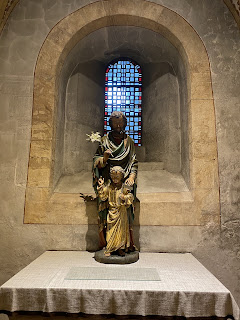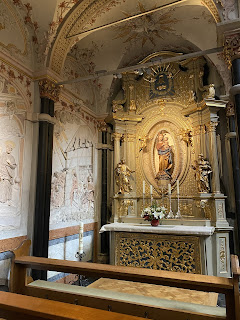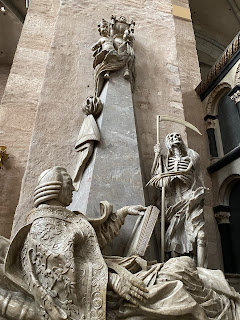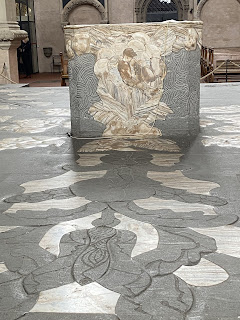Heute ist Kirchentag, also ein Tag, an dem ich lauter Kirchen besuchen will, denn für den Kirchenbesuch braucht man in Deutschland offiziell keinen Test, nur für Museen und Ausstellungen. Für Bildung muss man nachweisen, dass man gesund ist, für den Glauben ist das lässlich.
Da fange ich doch mal gleich mit dem Dom an. Der Dom steht auf einem römischen Wohnhaus, dort soll dem Vernehmen nach die Helena, die Mutter von Kaiser Konstantin gewohnt haben soll. Im 4. Jh, ca 310 bis 320, Konstantin beschloss, sich dem Christentum zuzuwenden und ließ entsprechend eine Basilika erbauen. Unter Bischof Maximin (hier ist der Name Programm) wurde die zum größten Kirchenbau Europas umgestaltet. Um 340 entstand der Quadratbau, dessen Dach von vier riesigen Granitsäulen aus dem Odenwald getragen wurde. Eine dieser Säulen kann man noch heute vor dem Dom liegend bestaunen.
Die Römer gingen irgendwann, die Basilika blieb, bis die Franken kamen, die zerstörten große Teile der Kirche und später die Wikinger auch noch einmal. Aber die Trierer bauten ihre Kirche unverdrossen immer wieder auf, und um, und passten sie dem Zeitgeist an. So findet man neben romanischen Elementen auch gotische und barocke Architektur und Dekoration in der Kirche. Während der Renaissance wurde im Ostchor die Heilig-Rock-Kapelle erbaut und es wurde viel Marmor verbaut.
Die Türme wurden mehrfach erhöht, besonders als der Turm der Bürgerkirche St. Gangolf die des Doms überragt hat, also, die Bürgerlichen über dem Klerus, das geht nun wirklich nicht. Mal hatten die Türme barocke Hauben, dann wieder neogotische Dächer. Im 19.Jh wurde viel renoviert und viel abgebaut, was nicht mehr passend erschien, und somit sind etliche barocke Kunstschätze verloren gegangen.
Im 2. Weltkrieg wurde der Dom getroffen, aber nicht schwer zerstört, so dass die Aufbauarbeiten relativ schnell abgeschlossen waren. Allerdings stellte sich später heraus, dass es doch erhebliche Beschädigung an der Statik des Gebäudes gab, was eine grundsätzliche Sanierung nach sich zog. Diese umfangreichen Sanierungen waren 1974 nach 14 Jahren abgeschlossen und in dieser Zeit wurde viel diskutiert, ob man dem Dom nicht ein einheitliches römisches Interieur verpassen solle. Zum Glück hat sich hier Geschichtsbewusstsein und nicht Nostalgie durchgesetzt und der Besuch im Dom ist eine architektonische Reise durch die Geschichte Europas.
Der Dom ist mit einer Länge von etwas über 100 Metern und einer Breite von 40 Metern nicht unbedingt die größte Kirche, die ich besucht habe, aber sie scheint magisch zu sein, denn drin erscheint sie größer als draußen. Bedingt ist das sicher durch die Kellerbereiche, die zugänglich sind und die Aufbauten auf dem Ostchor, die die Kapelle mit dem Heiligen Rock, der eher ein Kleid ist und aus dem Besitz des Religionsstifters selbst stammen soll. Es geht irgendwie ständig treppauf und treppab und jedesmal wenn man um eine Ecke oder durch einen Torbogen kommt, gibt es noch etwas Neues zu sehen.
Neben der Heiliger-Rock-Kapelle gibt es noch den Domschatz, allerdings kann ich den gerade nicht sehen, weil Bildung und Test und so. Vielleicht an einem anderen Tag.
Besonders gefallen hat mir die Marienkapelle mit ihren filigranen Schnitzereien, die barocke Decke im Westchor und die Bodenfliesen vor dem Altarraum, die fast wie Art Deco wirken. Trotz allem wirkt der Dom unglaublich maskulin, das ist mir noch nie so bei einer Kirche aufgefallen, es wirkt, wie ein Ort von Männern für Männer.
Gleich nebenan gibt es die Liebfrauenkirche, beide Häuser sind eigentlich verbunden, aber jemand hat einfach die Tür abgeschlossen. Allerdings gibt es zwischen den beiden Kirchen einen Kreuzgang, der auch sehenswert ist und ich verlasse diesen an der Ostseite und befinde mich dann in einer ganz ruhigen Seitenstraße hinter dem Dom, hier gab es offensichtlich in früherer Zeit die Wirtschaftsgebäude. Und durch kleine Seitenstraßen gelange ich zurück zum Domfreihof und zur Nachbarkirche.
English version below
It’s church day today, I will see many churches today, because you can see a church without testing, in Germany, officially. You need one for museums or exhibitions. For education you must prove you are healthy, for belief it’s not necessary.
I start with the Dom (Trier cathedral). It is standing on a Roman residence, the Helena, the mother of emperor Konstantin was once living on this spot. In the 4th century, between 310 and 320, Konstantin decided to turn to Christianity and let built a basilica. Unter the rule of bishop Maximin (the name says it all) it turned to be the grandest church in Europe at this time. Around 340 was a square room constructed with four granite pillars from Odenwald to hold the roof, one of those can still be seen at the entry.
Somewhen the Romans left, the cathedral remains, then came the Franconians and destroyed it, and later the Vikings as well. But the Trierer restored their church again and again, repaired it and renewed it and fitted it to the zeitgeist. That’s why we see beneath Roman styles gothic and baroque architecture and ornaments as well. During renaissance was the Heiliger-Rock-Kapelle (holy-robe-chapel) built on top of the eastern apse and a lot of marble was used.
The towers have been heightened several times, especially when the tower of the citizens church St. Gangolf was higher than those of the cathedral, the citizens above the clerkship, no way. One time the towers had baroque canopies and one time neo-gothic roof tops. In the 19th century was a lot of renovation done and many things have been removed which was seen as outmoded and a lot of baroque artwork might be lost.
In the WWII the cathedral was hit but not destroyed and it took only a short time to repair it. But unfortunately it turned out later that there was structural damage and a comprehensive repair was necessary. This reconstruction was finished in 1974 after 14 years and during this time there was a lot of discussion if the church should be brought back to the Roman style and interior. Lucky the decision was made to preserve the history than the nostalgia and now the visit of the cathedral is like a journey through the architecture of Europe.
The cathedral is about 100 meters long and 40 meters wide, and so it’s not the biggest church I’ve ever seen, but it seems it’s magic, it’s wider inside than it’s appears from outside. It may be like that because you can visit the huge basement and the setup on top of the east apse, which houses the chapel of the holy robe, what looks more like a dress and might once be owned by the founder of the religion itself. That’s what is told. It goes up the stairs and down the stairs and everywhere you make a turn something new can be recovered.
Beside the holy-robe-chapel is also the cathedral treasure displayed, but I can’t visit, since I have no test right, the test, the education, the belief, you remember… Maybe another day.
Most I liked St. Mary’s chapel with its delicate wood carvings, the baroque ceiling at the western apse and the floor tiles in front of the altar room, the are just like Art Deco. Regardless the cathedral is masculine, I never felt this in any other church, it feels like a place made by males for males.
Right next door is the Liebfrauenkirche (church of our lady), both buildings are connected, but someone locked the door. But between both churches is a cloister and it’s worth a visit too, and I leave the place at the east side and find myself in a quiet little lane behind the cathedral, seems to be the place for the outbuildings in former time. Back through tiny streets to the Domfreiplatz and the Liebfrauenkirche.





















































Keine Kommentare:
Kommentar veröffentlichen